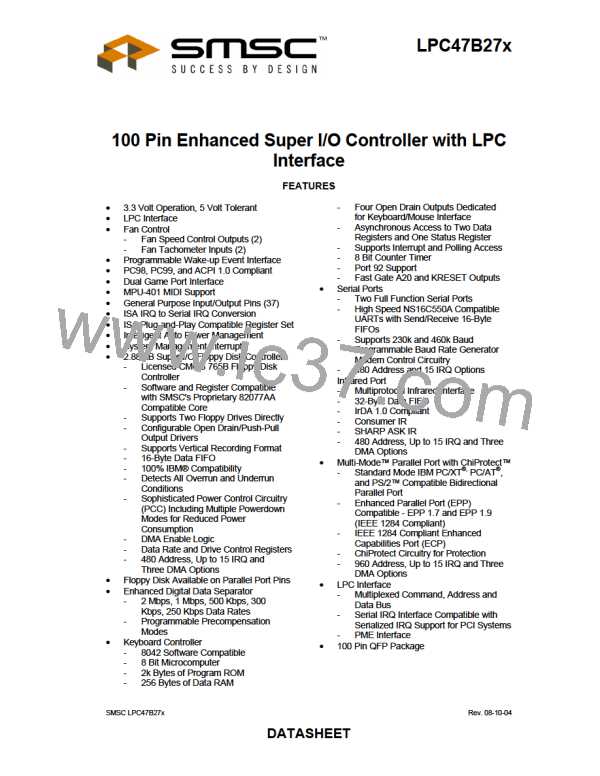These terms may be considered synonymous:
PeriphClk, nAck
HostAck, nAutoFd
PeriphAck, Busy
nPeriphRequest, nFault
nReverseRequest, nInit
nAckReverse, PError
Xflag, Select
ECPMode, nSelectln
HostClk, nStrobe
Reference Document: IEEE 1284 Extended Capabilities Port Protocol and ISA Interface Standard, Rev
1.14, July 14, 1993. This document is available from Microsoft.
The bit map of the Extended Parallel Port registers is:
D7
PD7
D6
D5
D4
D3
D2
D1
D0
Note
data
PD6
PD5
PD4
PD3
PD2
PD1
PD0
ecpAFifo
dsr
Addr/RLE
nBusy
0
Address or RLE field
Select
ackIntEn
2
1
1
2
2
2
nAck
0
PError
Direction
nFault
SelectIn
0
nInit
0
0
dcr
autofd
strobe
cFifo
ecpDFifo
tFifo
Parallel Port Data FIFO
ECP Data FIFO
Test FIFO
cnfgA
cnfgB
ecr
0
0
0
1
0
0
0
0
compress
intrValue
MODE
Parallel Port IRQ
nErrIntrEn
Parallel Port DMA
dmaEn
serviceIntr
full
empty
Note 1: These registers are available in all modes.
Note 2: All FIFOs use one common 16 byte FIFO.
Note 3: The ECP Parallel Port Config Reg B reflects the IRQ and DMA channel selected by the
Configuration Registers.
ECP IMPLEMENTATION STANDARD
This specification describes the standard interface to the Extended Capabilities Port (ECP). All LPC
devices supporting ECP must meet the requirements contained in this section or the port will not be
supported by Microsoft. For a description of the ECP Protocol, please refer to the IEEE 1284 Extended
Capabilities Port Protocol and ISA Interface Standard, Rev. 1.14, July 14, 1993. This document is
available from Microsoft.
Description
The port is software and hardware compatible with existing parallel ports so that it may be used as a
standard LPT port if ECP is not required. The port is designed to be simple and requires a small number of
gates to implement. It does not do any "protocol" negotiation, rather it provides an automatic high
burst-bandwidth channel that supports DMA for ECP in both the forward and reverse directions.
Small FIFOs are employed in both forward and reverse directions to smooth data flow and improve the
maximum bandwidth requirement. The size of the FIFO is 16 bytes deep. The port supports an automatic
handshake for the standard parallel port to improve compatibility mode transfer speed.
The port also supports run length encoded (RLE) decompression (required) in hardware. Compression is
accomplished by counting identical bytes and transmitting an RLE byte that indicates how many times the
next byte is to be repeated. Decompression simply intercepts the RLE byte and repeats the following byte
the specified number of times. Hardware support for compression is optional.
Table 41 - ECP Pin Descriptions
NAME
nStrobe
TYPE
DESCRIPTION
O
During write operations nStrobe registers data or address into the slave on
the asserting edge (handshakes with Busy).
Contains address or data or RLE data.
PData 7:0
I/O
SMSC LPC47B27x
- 81 -
Rev. 08-10-04
DATASHEET

 SMSC [ SMSC CORPORATION ]
SMSC [ SMSC CORPORATION ]